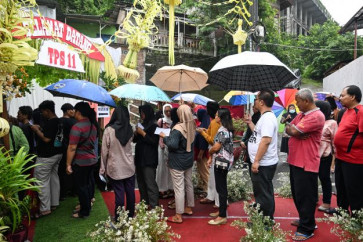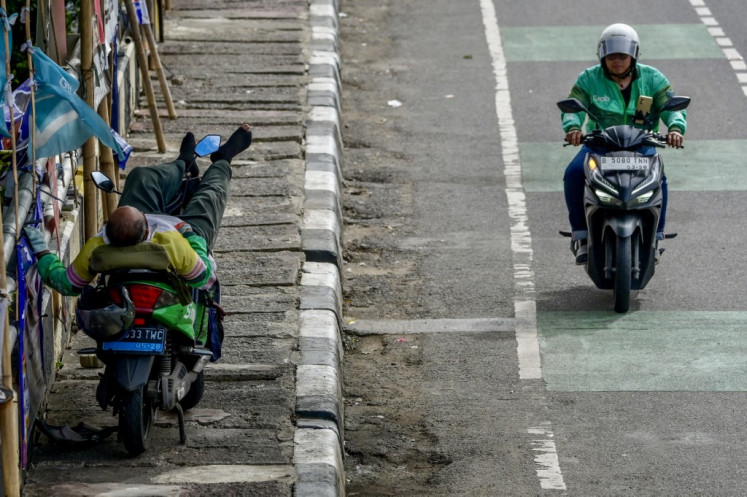Dancing in disguise
The Dayak Modang Hudoq mask dancers wear wooden masks representing the characters of crop pests or animal deities, during the inauguration of the harvest season

T
span class="inline inline-center">The Dayak Modang Hudoq mask dancers wear wooden masks representing the characters of crop pests or animal deities, during the inauguration of the harvest season. Sacred animals:
Behind a mask, one can become anything one wants: an angel or a beast, a deity or a demon, a simple facial guise can also take dancing to new levels of drama.
On one particular night, in less than half an hour, traditional West Javanese dancer Risyani became everything representing the extremes of the human character.
Behind a white smiling mask, she was a solemn, peaceful being. Later, under two red ones she transformed into a smug and forceful creature, as she danced the Priangan mask dance, a choreography of vigorous movements that only a handful of the modern generation know.
The dance that Risyani performed recently at South Jakarta’s Grha Bimasena was a rare piece. An almost extinct one, one might say.
A Sundanese take on the older Cirebon mask dance, the three-character dance was a masterpiece of the late Nugraha Soediredja, a choreographer who dedicated his life to modifying and reinterpreting traditional West Javanese dances.
Risyani was the last dancer to have the privilege of being taught by Nugraha himself.

That night, she first danced the graceful Kencana Wungu, taking to the stage with her feminine gestures. In the next two sub-episodes, her movements became increasingly vigorous and aggressive as she took on the roles of Patih Logender and Prabu Menakjingga.
If she were to dance the three characters only by changing her facial expression, the audience would probably have to work hard with their imagination to figure out the different personas. The masks she brought and wore one after another on stage worked wonders.
That’s what a mask does.
“The mask dance is part of our oldest traditions in art, yet it hasn’t received the spotlight and even tends to be forgotten,” says Bram Kushardjanto, organizer of the annual performance dedicated to keeping the art of dancing behind a mask alive.
Held for the second time since 2008, The Mask — a joint event between traditional performance producer Gelar and the Bimasena mining and energy society — tried to uncover what was left of the mask dance amid the country’s diverse cultural scene.
Previously, under the title “The Mask by the Maestro”, event organizers brought similar pieces from Betawi, Yogyakarta and Bali. That particular night, the works in the limelight were from West Java and East Kalimantan.
“In May, we’ve scheduled a performance from Simalungun [in North Sumatra],” Bram says.

Indeed, mask dancing is part of the traditional scene in almost every region in the country. Some were created out of artistic pursuits, such as the Priangan mask dance, while others evolved out of customs and rituals.
The Hudoq mask dance that took the stage afterward is among the latter. It is a ritual mask dance performed by the Dayak tribe of Kalimantan to inaugurate the planting season, cleanse the village and celebrate the harvest.
To the beat of traditional Dayak rhythms, nine dancers performed the ritual dance before and after harvesting time. Some of them are professionals, including Elly Luthan, and some are Dayak tribesmen.
Overseen by seasoned choreographer Deddy Luthan, it was a combined piece of the after-harvest mask dance ritual of the Dayak Modang and the customary ceremony of the Dayak Kenyah, usually performed when the rice plants have only just begun to bloom.
“The masks of the Dayak Modang represent beasts, sacred animals and deities. They are supposed to bless the harvest of that season,” Deddy says.
The Hudoq Modang dancers wore wooden masks carved in composite images of pests and dangerous animals. Garments made of bark, heavily fringed with shredded banana leaves, and completely covered the dancers. A feathered cap topped off the costume.
With no separate group of musicians pushing out the rhythm, the dancers double as musicians themselves as they stomped their feet and slapped their arms against their thighs – all covered in leaves, creating an additional thudding and whooshing.
Unlike professional stage dancing, ritual dances tend to be more of an egalitarian communal performance.
“The Dayak dance, despite the clear gender separation, is a kind of dance that treats men and women equally,” Elly says.
Pe Da’an, an 85-year-old woman considered the dance master of her tribe, led the group of dancers with her still clear, melodious voice.
In the Dayak Kenyah’s dance, female dancers hum and sing as they take the role of the rice goddess, against a male dancer wearing a wooden mask embellished with ornate curlicues and arabesque projecting from the ears. Both roles are of equal importance in the ritual dance.
“These kinds of dance are still performed in their tribes, but the masters of the dance have decreased in number,” says Deddy, who studied the Dayak Hudoq dance in 1974.
“Pe Da’an is among the last of her kind.”
The Dayak Kenyah Hudoq Kita is perhaps less extravagant compared to the Modang one. Yet it is just as enchanting.
The only complicated paraphernalia is the wooden mask worn by the male dancer, while others sport simpler box-shaped ones made of rattan baskets usually used to carry items around. Transformed into masks, the baskets are decorated with colorful beading.
Despite their differences, mask dances always remind us of the nature of humankind: A thousand-layered being who can choose to wear certain mental masks to project a desired image.
Which mask are you wearing today?
— Photos by Anissa S. Febrina









